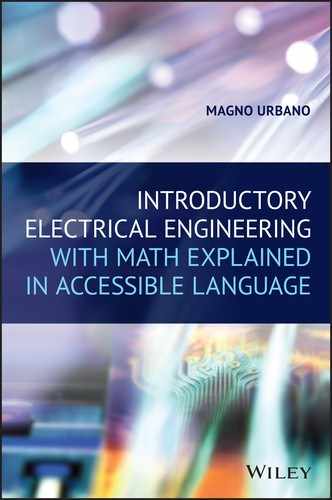15
Voltage and Current Sources: Circuit Analysis
15.1 Introduction
In this chapter, we will examine voltage and current sources and elements used actively to simplify and perform circuit analysis.
15.2 Independent DC Voltage Sources
An ideal voltage source is a two‐terminal device that can provide a constant voltage and zero internal resistance and can supply or absorb an infinite amount of power.
In real life, voltage sources will have voltages reduced if the load is too demanding and have a limited capacity to provide or absorb voltage.
Figure 15.1 shows their symbol and a circuit using a DC voltage source.

Figure 15.1 DC voltage source and a resistor.
15.3 Independent AC Voltage Sources
An AC voltage source works by the same principles as a DC voltage source but provides alternating voltage that follows a uniform pattern and has a constant frequency.
Figure 15.2 shows their symbol and a circuit using an AC voltage source.

Figure 15.2 AC voltage source and a resistor.
15.4 Dependent Voltage Sources
A dependent voltage source is a source that provides voltages which values depend on a voltage or current elsewhere in the circuit.
Dependent voltage sources are useful, for example, in examining the behavior of amplifiers or other kinds of circuits.
Figure 15.3 shows a circuit using a dependent voltage source which values depend on an input voltage.

Figure 15.3 Dependent voltage source with voltage control and a resistor.
Figure 15.4 shows a circuit using a dependent voltage source which values depend on an input current.

Figure 15.4 Dependent voltage source with current control and a resistor.
15.5 Independent Current Sources
An ideal current source is a two‐terminal device that can provide a constant current that will always keep its value and has an infinite internal resistance.
In real life, current sources can see their currents reduced if the load is too demanding and have a limited capacity to provide or absorb current.
Figure 15.5 shows an independent current source and a resistor.

Figure 15.5 Current source and a resistor.
Figure 15.6 shows alternative symbols for current sources.

Figure 15.6 Alternative symbols for current sources.
15.6 Dependent Current Sources
Dependent current sources are like independent current sources, but their values depend on voltages or currents elsewhere in the circuit.
Figure 15.7 shows a dependent current source which values depend on the input voltage.

Figure 15.7 Dependent current source with voltage control and a resistor.
Figure 15.8 shows a dependent current source which values depend on an input current.

Figure 15.8 Dependent current source with current control and a resistor.
